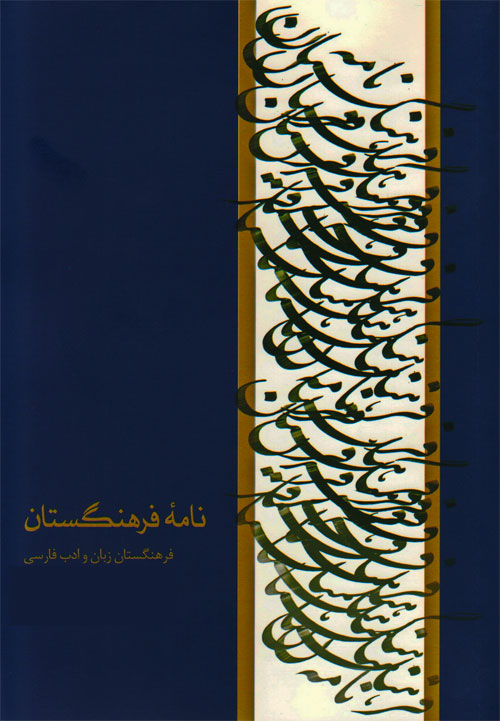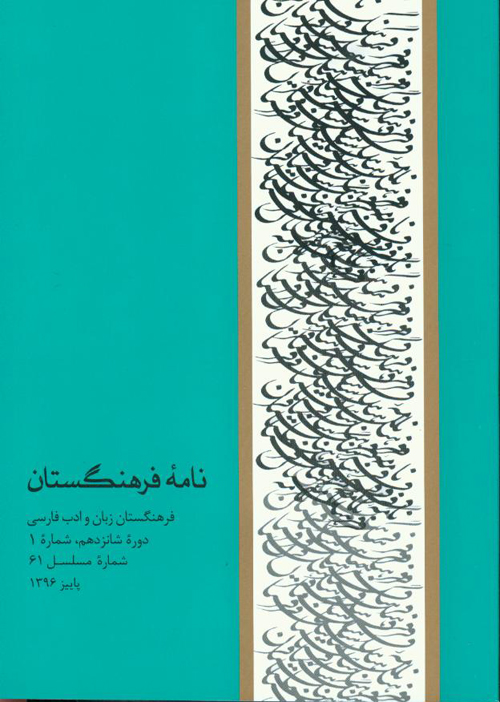فهرست مطالب

نامه فرهنگستان
سال پانزدهم شماره 1 (پاییز 1394)
- ویژه نامه ادبیات انقلاب اسلامی (2)
- تاریخ انتشار: 1394/08/17
- تعداد عناوین: 9
-
-
سرمقاله: ادبیات انقلاب اسلامی و رساله های دانشگاهیصفحه 3
-
وجوه نوگرایی غزل معاصر تاجیسکتان / با تاکید بر تاثیرپذیری از شعر معاصر ایران و شعر انقلاب اسلامیصفحه 26
-
Page 7Despite all stylistic differences, poetry of the first generation of the Islamic Revolution has had a common feature which is being influenced by Bidels mind and language. Poets of this generation, due to their personal style and their own thoughts have reflected a part of spectrum of Bidels style of poetry in their poems. Among them the lyric poets of Hindi style get more benefit out of it. The main issue of this project is the influence of Bidels poetry on the poetry of the first generation of the Islamic Revolution in both artistic and non-artistic areas as well as in the realms of rhetoric, figures of speech and the language. The results suggest that among all of these, Bidel-like symbols and similes in the domains of rhetoric, paradoxical images, compounding-sensations and personification in the field of figures of speech, and reversed compounds and numerical subordinates in linguistic area are more prominent. The lyrics of Yousef-Ali Mirshakkak, Ali Moallem Damghani, Seyyed Hassan Hosseini, Abdoljabbar Kakaei, Alireza Ghazveh, Saed Bagheri and Seyyed Mohammad Abbasieh Kohan which are studied in this paper are explicit instances of tendency of the poets of the first generation of the Islamic Revolution to Bidel; although the influential degree of each poet is different.Keywords: Bidel, influential degree, Hindi style, lyrics of Bidel, poets of the first generation of the Islamic Revolution
-
Page 26Contemporary ghazal of Tajikistan is a productive branch of Persian literature and rapidly undertook considerable changes. Socio-political changes of the independent Republics and the cultural changes have affected the nature of contemporary poetry of Tajikistan. The present paper, by benefiting from conceptual analysis method and with refer to published works of Tajik poets (eight classic and modern poets who are famous and influential in contemporary Tajik poems), attempts to examine some prominent aspects of todays Tajik Ghazals and different angles of the influence of contemporary poetry of Iran, especially the Islamic revolution poetry on Tajik poems from two various aspects: form and content.Keywords: Contemporary literature of Tajikistan, the ghazals of Tajikistan, contemporary literature of Iran, the Islamic revolution poetry
-
Page 46One of the most important differences between Persian classic literature and the modern literature is the poets or writers attitude towards his surrounding atmosphere and its impression. In the contemporary literary works, some signs of geographical and linguistic features as well as the traditions of the poets homeland and his place of residence can be found, but this kind of impressions can be seen very rarely in the Persian classic literature. Today, southern region of Iran with warm weather, palm groves, the Persian Gulf, huge rivers, etc., is of great interest to these poets and writers, and the above-mentioned features have been reflected in their works. One of the contemporary poets who was from south part of Iran and spent most of his life in this region is Mohsen Pezeshkiyan (1326-1358). He mostly lived in Kazeroun, Boushehr and Tehran where their regional elements were completely different. His poems have been profoundly influenced by his place of residence. The reflection of south sea, pharos and seagulls, palm groves, customs and manners, native words, proverbs and, on the whole, culture, dialect and geographical features in his poems demonstrate properly the native taste of his works. The present paper, through investigating the collection of his poems entitled Shesh Daftar (Six Booklets) defines and classifies the regional elements of his poems. Undoubtedly, the impression of south region on pezeshkiyans poems vary due to his lifestyle in different periods.Keywords: Mohsen Pezeshkiyan, Shesh Daftar, regional elements, poem of the south region, Kazeroun, Boushehr
-
Page 68The beginning of the imposed war was a starting point for the creation of a kind of narrative literature which still, after thirty years, there is no consensus on naming it. The major part of this kind of literature that was written based on revolutionary and Islamic thoughts is known as Holy Defense Literature. The holy defense novel is a type of story which was created on the basis of propagation and the design of religious values. This literary type has undergone various ups and downs, gradually steps toward the practice of modern techniques inthe field of narration. Sard-e Sefid is a post-modern novel by Kaveh Bahman. What appoints this novel in post-modern category is its nonlinear time of narration, change of narrator, short connection character's involvement, interlinear, confusion of elements of traditional plot, and revealing the problems of writing. Studies indicate that available techniques in this novel, have regional and native output, and are at the service of expanding ideological principle of the author. Bahman simultaneously experiences creating formal work in the field of holy defense and also tries to take advantage of post-modern techniques in a diminished form, conform to ideological output that focuses on different perspectives of Shahid Allah-Reza Latifpour's life, and tries not to offend against religious framework. He works on its content emphasizing on ideological process, idealism epic and religiosity. The result of this approach is the creation of this work of art that is interpreted as post-modern novel. This investigation, not only refers to the post-modern techniques in Sard-e Sefid, but also aims to depict how Kaveh Bahman takes advantage of form and content at the service of realization of religious ideology.Keywords: Holy defense novel, ideological post, modernism, Sard, e Sefid, Kaveh Bahman
-
Page 95One of the motives of the Islamic revolution poets in composing poems is expressing their grief on death of their relatives, contemporaries and martyrdom of revolutionary people and combatants. These poets have attempted, through transferring their poetic sense to the addressee, to relieve their mental suffering, as well as inviting others to sympathize with them. The main purpose of the present paper is to examine the poetic feeling and the way of transferring it in the elegy poems of Dr. Seyyed Ali Mousavi Garmaroudi. He is amongst those revolutionary poets who has got benefit from poetic techniques such as providing pictures compatible with his sadness and regret, use of past tense verbs, putting rhythm and sense in a harmonious way, creating an appropriate environment, continuity of feeling, etc. However, sometimes in his poems, for some reasons, he was not successful in transferring these poetic senses.Keywords: Elegy poems, lamentation, the Islamic revolution poetry, Mousavi Garmaroudi, affections
-
Page 118The present paper is a study of females characterization in two different plays by Alireza Naderi, namely, 77/6/31, and Whispers Beyond the Fighting Front based on Carl Jung's theories. This study, first, reviews Jung's theory about archetypes. Later, after giving a brief description about the plots of the two aforementioned plays, it examines females characterization within the archetypes framework. Eventually, by comparing the females characterization in the two plays, it demonstrates the similarities and differences of their characters.Keywords: Characterization, war plays, a female, Alireza Naderi, Carl Gustav Jung, Archetype
-
Page 135Critical discourse analysis is one of the approaches in discourse analysis in which
researcher improves text analysis from description to determination and interprets
text using elements such as ideology, authority, history, etc., Norman Fairclough is
one of the renowned authors in critical discourse analysis field. According to critical
discourse analysts, literary texts like other texts, are used for communication, thus,
they can be analyzed via a critical method. The present article tries to use
Faircloughs discourse analysis in three levels: description, explanation and
determination in reviewing Nakhalaf.Keywords: Critical discourse analysis, Fairclough, short story, Santamaria, “Nakhalaf”, Seyyed Mehdi Shojaei


